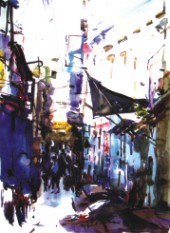|
Exhibition A Celebration of Colour
Ahmede Hussain
 |
Landscape, Watercolour, 2002 |
What sets Alakesh Ghosh apart from his peers' is his veritable display of minimalism in watercolour. A couple of dozen new watercolour paintings that are adorning the walls of Bengal Gallery of Fine Arts are primarily realistic in nature though, and it at times seems the artist has refused to play more with his content, the subject matter that is. He rather meticulously portrays a panoramic vision (we presume his own) of our forlorn landscape, but amidst this artistic lenience, we see him come up with bright bold strokes, particularly in Landscape. In this particular work, Ghosh's use of colour (and in places the careful, masterly absence of it) reminds one of the early Bengali masters. The work depicts disturbance, both in the “landscape” (one cannot but help but wonder if the artist should have been advised not to name it so obvious) and in the inner soul of the objects it holds. Surprisingly it is more abstract in nature, it is subtle and translucent; here Ghosh is at his best.
 |
Dark monsoon, Watercolour, 2006 |
In Bank of river Sangu (watercolour; 2006), like in Khagrachari, Ghosh creates multiple layers of narrative. A dash of light here and a daub of colour in places are good enough for him to narrate a story, a Bengal that is soothing to the eye. He does not quite get into the details, and for his field of vision is so wide that too detailing may have marred the beauty of a rural landscape (most of his new works evolve around rural Bengal, except for three, which are interestingly fairly vivid).
 |
Old Dhaka-2, Watercolour, 2007 |
Of his “urban watercolours”, Bara Katara is a work of wonder.
It shows the vibrancy of life in a narrow alley in an old part of the city. It throbs with life and at the same time the haunting presence of decay and, more enchantingly, loss, is a statement itself that Ghosh should draw the city more. The maze that Ghosh creates before our contented eyes is not only engaging but a delight to the senses. The speed and versatility with which it is drawn is evident in every stroke of the work, where multiple layers of image are clustered together to create a perfect harmony between life and chaos.
 |
| Sundarbans, Watercolour, 2006 |
Fishing Boat, among many in a series of boats, on the other hand, illustrates a boat standing shaky on a river. Though the land is barely visible, the narrow one-bamboo bridge is the only way to get to the ground from the boat, which is intelligently cornered at the right. We come across another boat (a dingy perhaps) in Sundarbans, here the artist's images are more abstract,
 |
Buffalo herd, Watercolour, 2007 |
yet it has a degree of motion in it-- especially the waves that thud at the land-- which reminds its beholder of speed and, to a certain extent, the vulnerability of the people living on that plain. The floating light of white and the circular motion of green add to the velocity of the
 |
| Fishing boat, Watercolour, 2001 |
composition. The trees on the left side seems tall and erected as a sharp weapon, and the depth of vision in the painting gives the image a new spectrum. Ghosh's world, however, is infested with the infamous Truth-Beauty dilemma that has plagued the Romantics for so long. The artist paints a beautiful world, an ideal one in which perhaps only Keats lived. In Ghosh's world, like his English counterpart's, you will find perfect harmony, which (alas) is an elusive dream in a society mired in abject poverty and economic subjugation. It is a utopian landscape that Ghosh works on, so you cannot blame him for not touching upon the plights of the people of the land he paints. Ghosh's world in that sense lacks the commitment to the real natural world that his kind of landscape painting so thoroughly demands, or perhaps his new works are the product of a transitory phase that will lead to a more enduring enlivening period in the life of this deft artist.
Copyright
(R) thedailystar.net 2007
|
| |
